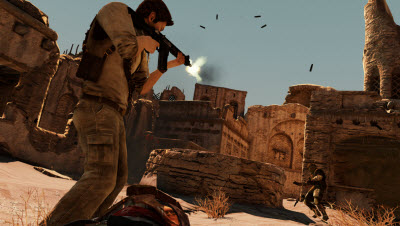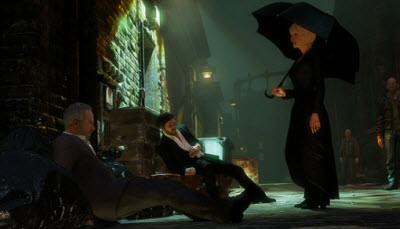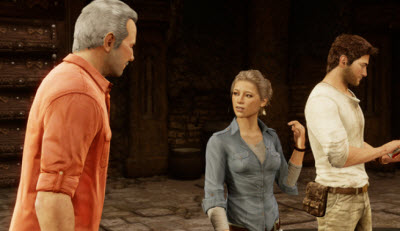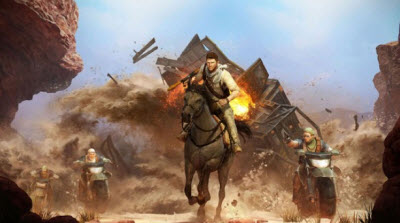VB: By and large, the game ran well for me. One problem I noticed and I think other gamers have noticed is that when you are turning while you are aiming, it takes 10 seconds to do a 360-degree turn. That was really slow. I wondered if that was a horsepower limitation of the hardware?
JR: Actually, when we did play tests, we found that most people wanted it to turn at that rate because it felt like if they turned any faster, they couldn’t aim right. They couldn’t get a bead on other characters. That was about the speed that you can aim at. You can increase that speed by messing with the controller settings to make your speed faster or slower. But in general that was the average that people seemed to like.
 VB: And then I guess some people still had complaints about the accuracy of aiming?
VB: And then I guess some people still had complaints about the accuracy of aiming?
JR: We are definitely looking at that. We have taken into account all that stuff and tried to figure out where people are having problems. We are looking at what we can do to help people in that arena. We haven’t announced anything, but we are definitely looking at it.
VB: It sounds like the aiming was different from Uncharted 2 in some way, right?
JR: The whole system is completely different. When we started Uncharted 3, we found that at the end of Uncharted 2, people were telling us they were missing targets because of the way the aiming behavior worked. We adjusted that and tried to fix it in this game. I think there is some amount of adjustment that people need to make. But also there clearly are some people who seem to have more difficulty aiming in the game. In some cases, we are looking at what we can do to help those people. I think by and large those people are a minority.
VB: So the hardware is not limiting any of the game play right now?
JR: No. I don’t think so. Hardware is always going to limit you in some sense, which is good. You want to have something that says you can’t go too far. You want to design in some kind of limit, but, no, I think mostly whatever we can dream up that sits in the universe and we feel like is fun to play, we can do. We are not hitting the limit of what can be done. We are thinking more about what we want to do and how we want to play it.
 VB: I noted in our review that so much happens in the cinematic form at the beginning of the game. You tell so much of a story in a movie-like way, and I think it is maybe level four or five before you actually start any shooting. Can you talk about that beginning and how you thought about this?
VB: I noted in our review that so much happens in the cinematic form at the beginning of the game. You tell so much of a story in a movie-like way, and I think it is maybe level four or five before you actually start any shooting. Can you talk about that beginning and how you thought about this?
JR: Sure. I don’t want to ruin anything for people who haven’t played it yet. But we spent lot of time trying to figure out exactly how we wanted to start the game out. We wanted to have this big brawl, this big set piece. We show them how to do the melee system and then show them something of what is happening in the story but not exactly what is happening for the sake of mystery. But then obviously the second and third levels are completely different from anything we have done before. It is really nice that at the beginning of the game, you get the sort of more to know about Drake. Who is he? Where does he come from? All of these kinds of things. And then the player is eased into the shooting. That’s better than starting off with a weapon and trying to learn it right a way. I think it is something that the fans really liked and have had a positive reaction to it.
 VB: And here in this beginning, it becomes clear that Sully and Drake’s relationship was central to the game, as opposed to a more romantic story of Uncharted 2. What kind of thinking went into getting your focus on that?
VB: And here in this beginning, it becomes clear that Sully and Drake’s relationship was central to the game, as opposed to a more romantic story of Uncharted 2. What kind of thinking went into getting your focus on that?
JR: I think we always found that fans were asking for more Sully, more Sully, more Sully since the first game we did. Amy was really drawn to the idea of where did these guys come from, where did they meet, who is Sullivan to Drake? Is he Drake’s savior? He is Drake’s corruptor in some sense and what does that mean to those two guys and their relationship and how do they actually interact with each other. Why are they the way they are? That is how the game started. We were trying to go there and make the tension between them feel real. It wasn’t just fan service. It was explaining why they were together.
VB: I didn’t really think about that savior and corrupter angle.
JR: Yeah. Would Drake be who he was without Sullivan, and would Sullivan be who he was without Drake? Those are interesting things to look at and play with.

